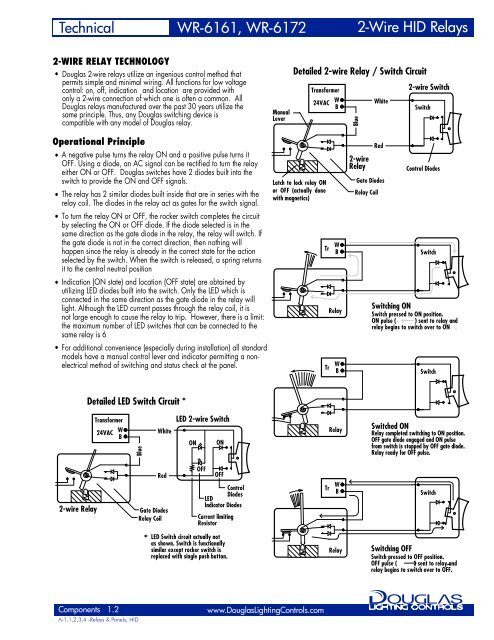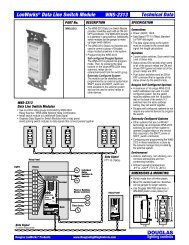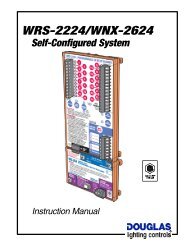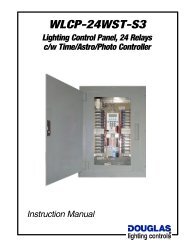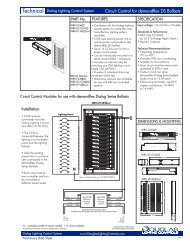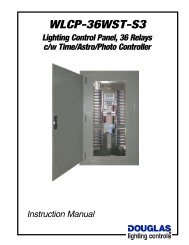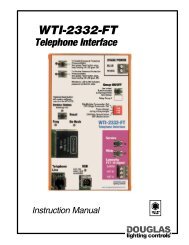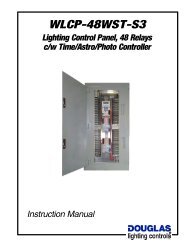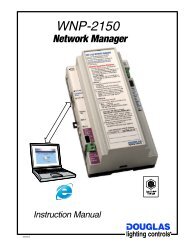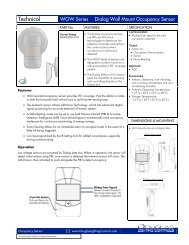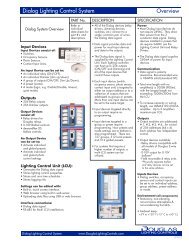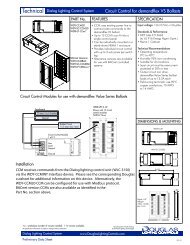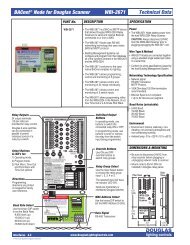nonelectrical
Relays + PWEx Panels + Transformers.pdf - Douglas Lighting Control
Relays + PWEx Panels + Transformers.pdf - Douglas Lighting Control
- No tags were found...
Create successful ePaper yourself
Turn your PDF publications into a flip-book with our unique Google optimized e-Paper software.
Technical<br />
WR-6161, WR-6172<br />
2-Wire HID Relays<br />
2-WIRE RELAY TECHNOLOGY<br />
• Douglas 2-wire relays utilize an ingenious control method that<br />
permits simple and minimal wiring. All functions for low voltage<br />
control: on, off, indication and location are provided with<br />
only a 2-wire connection of which one is often a common. All<br />
Douglas relays manufactured over the past 30 years utilize the<br />
same principle. Thus, any Douglas switching device is<br />
compatible with any model of Douglas relay.<br />
Manual<br />
Lever<br />
Detailed 2-wire Relay / Switch Circuit<br />
Transformer<br />
24VAC<br />
W<br />
B<br />
Blue<br />
White<br />
2-wire Switch<br />
Switch<br />
Operational Principle<br />
• A negative pulse turns the relay ON and a positive pulse turns it<br />
OFF. Using a diode, an AC signal can be rectified to turn the relay<br />
either ON or OFF. Douglas switches have 2 diodes built into the<br />
switch to provide the ON and OFF signals.<br />
• The relay has 2 similar diodes built inside that are in series with the<br />
relay coil. The diodes in the relay act as gates for the switch signal.<br />
• To turn the relay ON or OFF, the rocker switch completes the circuit<br />
by selecting the ON or OFF diode. If the diode selected is in the<br />
same direction as the gate diode in the relay, the relay will switch. If<br />
the gate diode is not in the correct direction, then nothing will<br />
happen since the relay is already in the correct state for the action<br />
selected by the switch. When the switch is released, a spring returns<br />
it to the central neutral position .<br />
• Indication (ON state) and location (OFF state) are obtained by<br />
utilizing LED diodes built into the switch. Only the LED which is<br />
connected in the same direction as the gate diode in the relay will<br />
light. Although the LED current passes through the relay coil, it is<br />
not large enough to cause the relay to trip. However, there is a limit:<br />
the maximum number of LED switches that can be connected to the<br />
same relay is . 6<br />
• For additional convenience (especially during installation) all standard<br />
models have a manual control lever and indicator permitting a <strong>nonelectrical</strong><br />
method of switching and status check at the panel.<br />
Latch to lock relay ON<br />
or OFF (actually done<br />
with magnetics)<br />
Tr<br />
Tr<br />
W<br />
B<br />
Relay<br />
W<br />
B<br />
2-wire<br />
Relay<br />
Gate Diodes<br />
Relay Coil<br />
Red<br />
Control Diodes<br />
Switch<br />
Switching ON<br />
Switch pressed to ON position.<br />
ON pulse ( ) sent to relay and<br />
relay begins to switch over to ON .<br />
Switch<br />
Detailed LED Switch Circuit *<br />
Transformer<br />
24VAC<br />
W<br />
B<br />
Blue<br />
White<br />
LED 2-wire Switch<br />
ON<br />
ON<br />
Relay<br />
Switched ON<br />
Relay completed switching to ON position.<br />
OFF gate diode engaged and ON pulse<br />
from switch is stopped by OFF gate diode.<br />
Relay ready for OFF pulse.<br />
2-wire Relay<br />
Red<br />
Gate Diodes<br />
Relay Coil<br />
OFF<br />
OFF<br />
Control<br />
Diodes<br />
LED<br />
Indicator Diodes<br />
Current limiting<br />
Resistor<br />
Tr<br />
W<br />
B<br />
Switch<br />
*<br />
LED Switch circuit actually not<br />
as shown. Switch is functionally<br />
similar except rocker switch is<br />
replaced with single push button.<br />
Relay<br />
Switching OFF<br />
Switch pressed to OFF position.<br />
OFF pulse ( ) sent to relay and<br />
relay begins to switch over to OFF.<br />
Components 1.2<br />
A-1.1,2,3,4 -Relays & Panels, HID<br />
www.DouglasLightingControls.com


